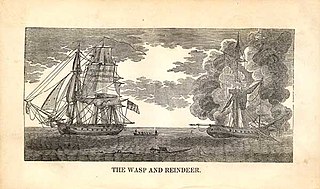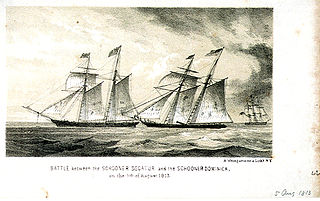
HMS Belvidera was a Royal Navy 36-gun Apollo-class frigate built in Deptford in 1809. She saw action in the Napoleonic Wars and the War of 1812 and continued a busy career at sea into the middle of the 19th century. In 1846 she was reduced to harbour service, in 1860 she became a receiving ship, and she was finally disposed of in 1906.

HMS Poictiers was a 74-gun Royal Navy third rate. This ship of the line was launched on 9 December 1809 at Upnor. During the War of 1812 she was part of the blockade of the United States. She was broken up in 1857.

HMS Reindeer was a Royal Navy 18-gun Cruizer-class brig-sloop of the Royal Navy, built by Samuel & Daniel Brent at Rotherhithe and was launched in 1804. She was built of fir, which made for more rapid construction at the expense of durability. Reindeer fought in the Napoleonic Wars before succumbing in 1814 to the guns of USS Wasp during the War of 1812.

HMS Kingfisher was a Royal Navy 18-gun ship sloop, built by John King and launched in 1804 at Dover. She served during the Napoleonic Wars, first in the Caribbean and then in the Mediterranean before being broken up in 1816.

HMS Forester was a Royal Navy 18-gun Cruizer-class brig-sloop built by John King and launched in 1806 at Dover. She had a relatively uneventful career before the Navy sold her in 1819.
HMS Highflyer was originally an American privateer schooner built in 1811. As a privateer she took several British vessels as prizes. The Royal Navy captured her in 1813. She then participated in several raids on the Chesapeake and coastal Virginia before the Americans recaptured her later in 1813.

HMS St Lawrence was a 14-gun schooner of the Royal Navy. She had been built in 1808 in St. Michaels, Talbot County, Maryland for Thomas Tennant and sold to Philadelphians in 1810. During the War of 1812 she was the US privateer Atlas. The UK captured her in 1813 and renamed her St Lawrence. The US privateer Chasseur recaptured her in 1815, and then HMS Acasta re-recaptured her.
HMS Telegraph was built in 1812 in New York as the American letter of marque Vengeance. The Royal Navy captured her in 1813 and took her into service as the 14-gun schooner or gunbrig Telegraph. Over a period of only about two years she took numerous small prizes and caused the destruction of a French 16-gun brig. A gale caused the wrecking of Telegraph in 1817.
HMS Landrail was a Cuckoo-class schooner built by Thomas Sutton at Ringmore, Teignmouth. Like all her class she carried four 12-pounder carronades and had a crew of 20. She had a relatively uneventful career during the Napoleonic Wars and the War of 1812 until 1814 when she was taken in a notable action, and then retaken. She was sold in approximately 1818.
HMS Ballahoo was the first of the Royal Navy's Ballahoo-class schooners, vessels of four 12-pounder carronades and a crew of 20. The prime contractor for the vessel was Goodrich & Co., in Bermuda, and she was launched in 1804. She patrolled primarily in the Leeward Islands, taking several small prizes, before an American privateer captured her in 1814 during the War of 1812.
HMS Shelburne was the American letter of marque schooner Racer, built in Baltimore in 1811 and captured by the British in 1813. She served on the American coast, capturing the American brig Frolic. She also captured some merchantmen and was sold in Britain in 1817.
The capture of HMS Dominica was a notable single-ship action that occurred on 5 August 1813 off the Bermudas during the War of 1812. American privateer Decatur and the Royal Navy schooner Dominica engaged in a fierce contest that ended with the capture of Dominica after a long battle.
HMS Colibri was the French naval Curieux-class brig Colibri, launched in 1808, that the British captured in 1809 and took into the Royal Navy under her existing name. She spent her time in British service on the North American station based in Halifax, Nova Scotia. During the War of 1812, Colibri served mostly in blockading the American coast and capturing privateers and merchant ships. She foundered in 1813 in Port Royal Sound, South Carolina, but without loss of life.

HMS Dominica was the French letter of marque schooner Duc de Wagram, which the British captured in 1809 in the Leeward Islands and took into the Royal Navy in 1810. The American privateer Decatur captured her in 1813 in a notable single-ship action. However, Majestic recaptured her in 1814. She was wrecked in 1815
HMS Canso was the American letter of marque schooner Lottery, launched in 1811, that a British squadron captured in 1813. The Royal Navy took Lottery into service as HMS Canso and she served during the War of 1812 and briefly thereafter. The navy sold her in 1816.
HMS Express was the name-ship of a class of two schooner-rigged advice-boats of the Royal Navy. Express was launched in 1800 and served until she was sold in 1813. During her career she served in one action and one campaign that in 1847 qualified her surviving crew members for clasps to the Naval General Service Medal.
HMS Grenada was the French schooner Harmonie, launched in 1800 and armed at Cayenne in 1803 as a privateer. Boats of a squadron of the British Royal Navy cut her out from the harbour of Le Marin, Martinique, on 16 November 1803. The citizens of Grenada purchased her and donated her to the Royal Navy, which commissioned her in 1804 as HMS Grenada. She was later converted to a brig. She captured nine small French privateers before being sold for breaking up in 1810.
HMS Elizabeth was a French privateer schooner that the Royal Navy captured in 1805 and took into service under her existing name. She participated in an engagement and a campaign that earned her crews clasps to the Naval General Service Medal. She was lost with all hands in 1814 when she capsized in the West Indies.

HMS Wanderer was a Cormorant-class ship-sloop launched in 1806 for the Royal Navy. The Royal Navy sold her in 1817. She made one voyage between 1817 and 1820 as a whaler in the British southern whale fishery. She then sailed between Plymouth and North America until October 1827 when her crew had to abandon her at sea because she was waterlogged.
Dame Ernouf first appears under that name in 1807. Her origins are currently obscure. She served as a privateer first under that name, and then under the name Diligent. As Diligent she not only capture several merchantmen but also two British Royal Navy vessels: a schooner and a brig. She continued to capture prizes until the end of 1813 and then disappears from online records.







